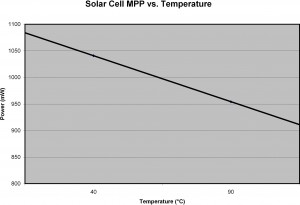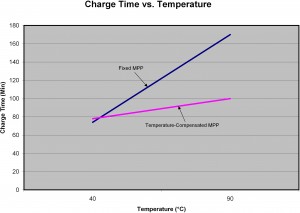Michael Day and Javed Casey, Power Management Group, Texas Instruments
Solar cells are a very popular solution for providing cheap, green energy. They are useful in applications where standard AC line power is not available, or where the power grid is intermittent and unreliable in rural areas such as parts of India and other developing nations. A typical system might be designed to use a solar cell for charging a battery during daylight hours, and then allow the battery to power the end application such as a solar-powered lantern during the night or under cloudy conditions.
Using extremely simple, inexpensive charging circuits to connect the solar cell to the battery does not efficiently convert solar power into usable energy and can damage the battery due to over- and under-charge conditions. A well-designed charging system should maximize the solar cell energy to minimize both the size and the cost of the solar cells. It should also provide battery protection circuitry to ensure the battery is only operated within its recommended limits. This ensures maximum battery life and protects against possible battery fire or an explosion.

Understanding a solar cell’s operating characteristics is a necessary component to optimize overall system efficiency. Figure 1 shows a solar cell’s V-I curve.
The highest solar cell voltage occurs with an open circuit. No power is delivered at this operating condition. The highest current occurs with a short circuit, but no power is delivered at this operating condition either. This implies that the solar cell must have a maximum power point (MPP) somewhere between these two conditions. Figure 1 displays the solar cell’s output power versus operating voltage. The power traces are calculated by multiplying the current-axis and x-axis. A properly designed system should operate at the solar cell’s MPP. Conceptually, it is fairly easy to operate at this point simply by designing the solar cell’s load to consume any amount of current up to the solar cell’s MPP current, but no more than this.
For a standard Lithium-Ion (Li-Ion) battery charger operating in constant current-charge mode, often called fast charge [1], the battery charger delivers a constant current to the battery, independent of battery voltage. This works well with a standard power source to the system because these sources are typically well-regulated and their current capability exceeds that which is needed by the charger. A solar cell’s operational characteristics provide a challenge in battery-charging applications. Operating at too low of a current does not efficiently use the solar cell’s power capability. Operating at too high of a current causes the solar cell voltage to drop too low to be usable. Consider three different operating points in fast-charge mode.
The first operating point is defined where the load pulls less current than the solar cell’s IMPP. This operating point ensures that the solar cell’s voltage does not drop too low, but does not pull the maximum power available from the solar cell. If the system load only requires a current that is less than the solar cell’s IMPP, then there are no drawbacks to operating at this point. However, if the user artificially sets the maximum available current lower than IMPP, the solar cell power is not fully utilized and the system takes longer to charge the battery than necessary.
The second operating point occurs when the load pulls more than the solar cell’s IMPP. At this point, the solar cell voltage drops and reduces the available power. If the load tries to pull too much current from the solar cell, the voltage eventually collapses, halting any charge to the battery. The current then drops and the solar cell voltage rises, allowing the charger to start the process all over again. This operation significantly reduces the solar cell’s available power because the system spends a large percentage of its time either turned off or restarting.
The third operating point is defined at the solar cell’s MPP where the system takes full advantage of the solar cell’s maximum output power capability. This design allows the load (battery and system) to pull its required current, but only up to the solar cell’s IMPP.
A battery charger specifically designed for solar cell charging applications with built-in functionality helps to operate a solar cell at its MPP. In addition to the normal internal control loops designed to maintain the battery’s voltage and current regulation, a solar cell charger has an additional control loop. The maximum power point tracking (MPPT) loop monitors the solar cell output voltage and overrides the other control loops, if the system tries to pull too much current. When the system consumes less than the solar cell’s MPP, the solar cell’s output voltage is above VMPP and this loop becomes inactive. As the system pulls more current, the solar cell’s output voltage drops. When it drops to its VMPP, the MPPT control loop overrides the existing control loops and regulates the maximum solar cell current to maintain the solar cell voltage at VMPP. This function allows the system to pull up to, but not more than, the solar cell’s maximum output power. When the system load decreases, the MPPT control loop is disabled and standard charger control resumes.

Operating at the solar cell’s MMP is a simple task at any specific temperature. Unfortunately, a solar cell’s MPP changes with temperature. Figure 2 shows this change in MPP over temperature.
A charger designed with a fixed MPP under-utilizes a solar cell’s available power when operated at any temperature other than the specific temperature for which it was designed. This requires larger solar cells to achieve the same charge time. For example, when a charger with fixed MPP optimized for a solar cell’s 40°C MPP is operated at 90°C, it operates the solar cell well below its 90°C MPP. Under these conditions, the solar cell only provides approximately 75 percent of its available power. Figure 3 shows a circuit that uses a negative temperature coefficient (NTC) resistor to adjust the charger’s MPPT voltage setting across changes in temperature. This allows the charger to track the solar cell’s MPP and fully utilize all available power across temperature variations. Properly selecting the component values is fairly complicated, but an Excel spreadsheet [2] is available to help you through the process.

Using the design spreadsheet as a guide, we built and tested a temperature compensated MPPT circuit, again using the bq24650. The circuit is powered by a 13.6 V (VOC), 240 mA (ISC) solar cell. The MPPT circuit was tested, with and without temperature compensation, and connected to a 4.2 V, 160 mA-hr polymer Li-Ion battery. Optimizing the design for 40°C and operating the solar cell at 40°C results in a 74-minute charge time. However, when the actual operating temperature is increased to 90°C, the charge-time increases to 170 minutes, or a 130 percent increase. The same test conditions using the temperature compensating NTC circuit result in a 78-minute charge time at 40°C, and a 100-minute charge time at 90°C.
Although the longer charge time at 90°C is expected because a solar panel’s power capability drops with increasing temperature, the NTC temperature compensated circuit provides a 41 percent reduction in charge time, versus not using a fixed-temperature design. Figure 4 shows charge time versus temperature for both a fixed 40°C optimized charge circuit and a NTC temperature compensated charge circuit. Because the temperature compensated design maximizes solar cell power at all temperatures, it always provides a reduction in charge time.

While solar panel power utilization and charge times are always important design specifications, battery life and safety also need to be considered. Frequent over-charging or discharging significantly reduces a battery’s lifetime. Extremely discharged Li-Ion batteries must be slowly conditioned with a trickle charge before a full-charge cycle can begin. Although not dangerous, applying full-charge current to a heavily discharged battery reduces its lifetime.
Select a battery charger that provides a pre-charge threshold to properly condition the battery prior to entering the fast-charge mode. Overcharging a Li-Ion battery can have serious consequences that range from simply reducing battery life to potential explosion.
To quantify this, repeatedly overcharging a Lithium Cobalt- (LiCo02) based battery by only 150 mV above the recommended level reduces the battery capacity by 50 percent in only 200 charge cycles. A single 300 mV overcharge can result in catastrophic failure, resulting in fire or explosion. With a tightly regulated charge voltage of +/–0.5 percent, chargers like the bq24650 ensure safe charging voltages and maximum battery life. Charging above and below recommended charging temperatures is also dangerous and can reduce battery life. Look for a solar battery charger that incorporates circuitry that qualifies the battery temperature and either prevents charging or suspends charging, if the temperature falls outside of the design limits.
Summary
Fully utilizing solar cell power capability, maintaining safe battery charge voltages, and qualifying allowable charging temperatures are important design parameters in a solar-charging application. Simple, discrete charge circuits do not provide the required functionality needed to meet these design requirements. Designers should turn to ICs specifically designed for this type of application. Their maximum power point tracking circuitry reduces solar cell size requirements and battery charging time while their built-in safety circuitry maintains battery life and ensures the safety of the system.
References
1. Download a datasheet for the bq24650 here: www.ti.com/bq24650-ca.
2. BQstroller calculation tools: www.ti.com/bqstrollertool-ca.
3. For more information about other solar solutions from TI, visit:
www.ti.com/solar-ca.
4. See videos, ask questions and share knowledge on the TI E2ETM
Community: www.ti.com/e2e-ca.
Michael Day, Power Management Application supervisor for Texas Instruments’ Power organization, has 16 years design experience in the field of power conversion. Currently, Michael manages the DC/DC Power Applications group at TI. He received his BSEE and MSEE in Pulsed Power from Texas Tech University, Lubbock, Texas. Michael is a member of IEEE and has published more than 60 articles on power, portable power and lighting topics.
Javed Casey is an applications engineer with the Battery Management Group at Texas Instruments. He received his BS Electrical Engineering and BS Computer Science from Texas Tech University, Lubbock, Texas.
This article printed in the March/April 2011 issue of Battery Power magazine.







